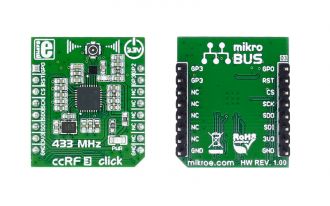
We strongly encourage users to use Package manager for sharing their code on Libstock website, because it boosts your efficiency and leaves the end user with no room for error. [more info]

Rating:
Author: MIKROE
Last Updated: 2019-07-31
Package Version: 1.0.0.1
mikroSDK Library: 1.0.0.0
Category: 2.4 GHz Transceivers
Downloaded: 5083 times
Not followed.
License: MIT license
ccRF 3 click carries the CC1120 high-performance RF transceiver for narrowband systems from Texas Instruments. The clicks will enable you to add a low-power consumption radio transceiver at 433 MHz frequency. ccRF 3 click is designed to run on a 3.3V power supply. It communicates with the target microcontroller over SPI interface.
Do you want to subscribe in order to receive notifications regarding "ccRF 3 click" changes.
Do you want to unsubscribe in order to stop receiving notifications regarding "ccRF 3 click" changes.
Do you want to report abuse regarding "ccRF 3 click".

Library Description
The library covers all the necessary functions to control ccRF 3 Click board. A library performs the communication with the device via SPI interface with CC1120 single-chip radio transceiver.
Key functions:
uint8_t ccrf3_readByteReg( uint16_t regAddress ) - Read the byte of data function.void ccrf3_writeBytesReg( uint16_t regAddress, uint8_t *writeData, uint8_t nBytes ) - Sequential write data function.uint8_t ccrf3_writeTXfifo( uint8_t *writeData, uint8_t nBytes ) - Write TX FIFO register function.Examples description
The application is composed of the three sections :
void applicationTask()
{
char receivedData;
if ( UART_Rdy_Ptr() )
{
receivedData = UART_Rd_Ptr();
switch ( receivedData )
{
case 'T' :
{
modeSelected = _CCRF3_TX_MODE;
sendFlag = 0;
readingFlag = 0;
Delay_ms( 200 );
ccrf3_setTXmode();
mikrobus_logWrite( " TX Mode ", _LOG_LINE );
mikrobus_logWrite( "----------------------", _LOG_LINE );
break;
}
case 'R' :
{
modeSelected = _CCRF3_RX_MODE;
receiveFlag = 0;
ccrf3_setRXmode();
readingFlag = 1;
mikrobus_logWrite( " RX Mode ", _LOG_LINE );
mikrobus_logWrite( "----------------------", _LOG_LINE );
break;
}
case 'I' :
{
modeSelected = _CCRF3_IDLE_MODE;
mikrobus_logWrite( " Idle Mode ", _LOG_LINE );
mikrobus_logWrite( "----------------------", _LOG_LINE );
break;
}
}
}
switch( modeSelected )
{
case _CCRF3_TX_MODE:
{
ccrf3_sendTXdata( &txBuffer[ 0 ], 8 );
Delay_ms( 1000 );
break;
}
case _CCRF3_RX_MODE:
{
if ( readingFlag )
{
ccrf3_receiveRXdata( &rxBuffer[ 0 ] );
lengthRx = sizeof( rxBuffer );
for ( cnt = 0; cnt < lengthRx; cnt++ )
{
mikrobus_logWrite( " rxBuffer[ ", _LOG_TEXT );
ByteToStr( cnt, logText );
ltrim( logText );
rtrim( logText );
mikrobus_logWrite( logText, _LOG_TEXT );
mikrobus_logWrite( " ] = ", _LOG_TEXT );
ByteToStr( rxBuffer[ cnt ], logText );
ltrim( logText );
mikrobus_logWrite( logText, _LOG_LINE );
}
Delay_ms( 1000 );
mikrobus_logWrite( "----------------------", _LOG_LINE );
}
break;
}
}
}
Other mikroE Libraries used in the example:
SPIUARTConversionAdditional notes and informations
Depending on the development board you are using, you may need USB UART click, USB UART 2 click or RS232 click to connect to your PC, for development systems with no UART to USB interface available on the board. The terminal available in all MikroElektronika compilers, or any other terminal application of your choice, can be used to read the message.